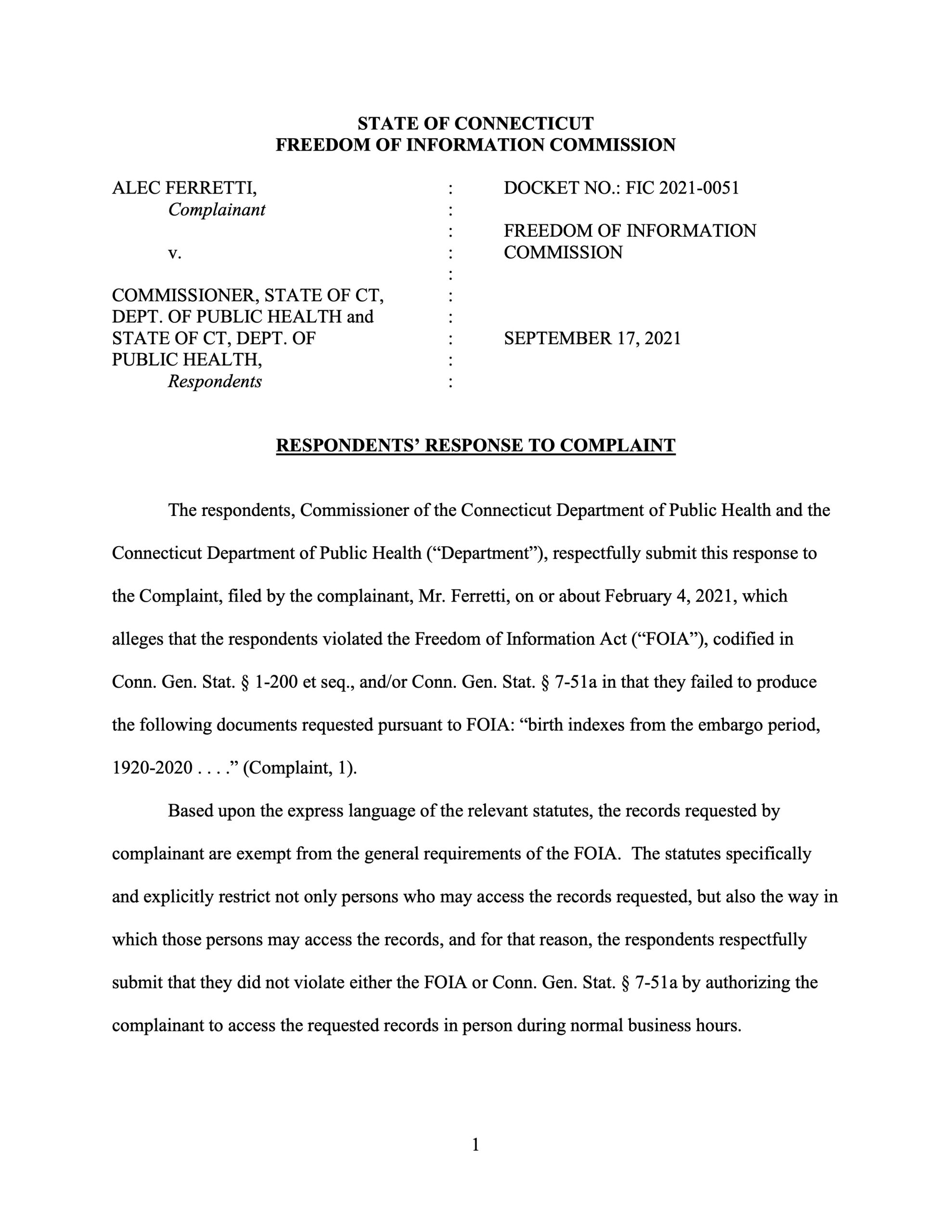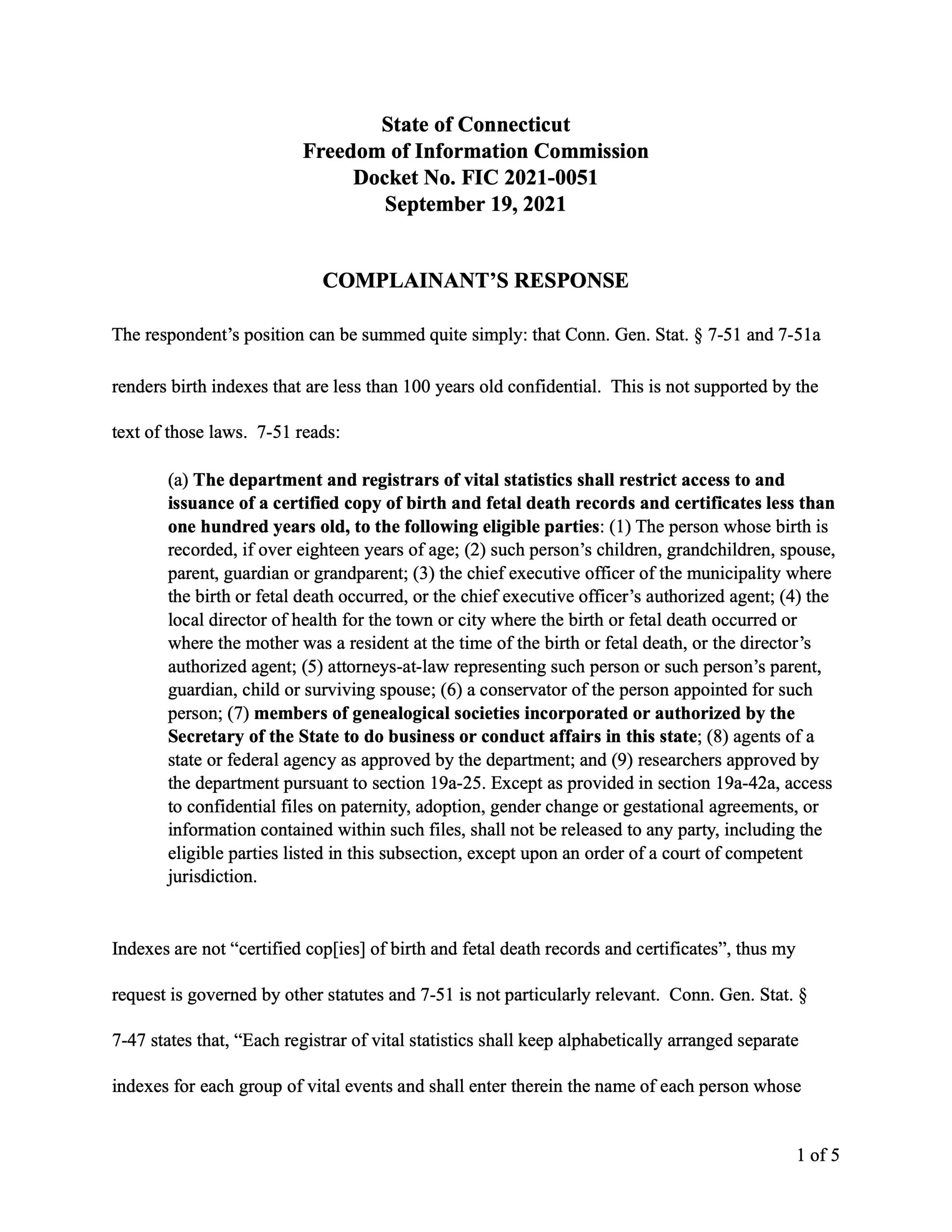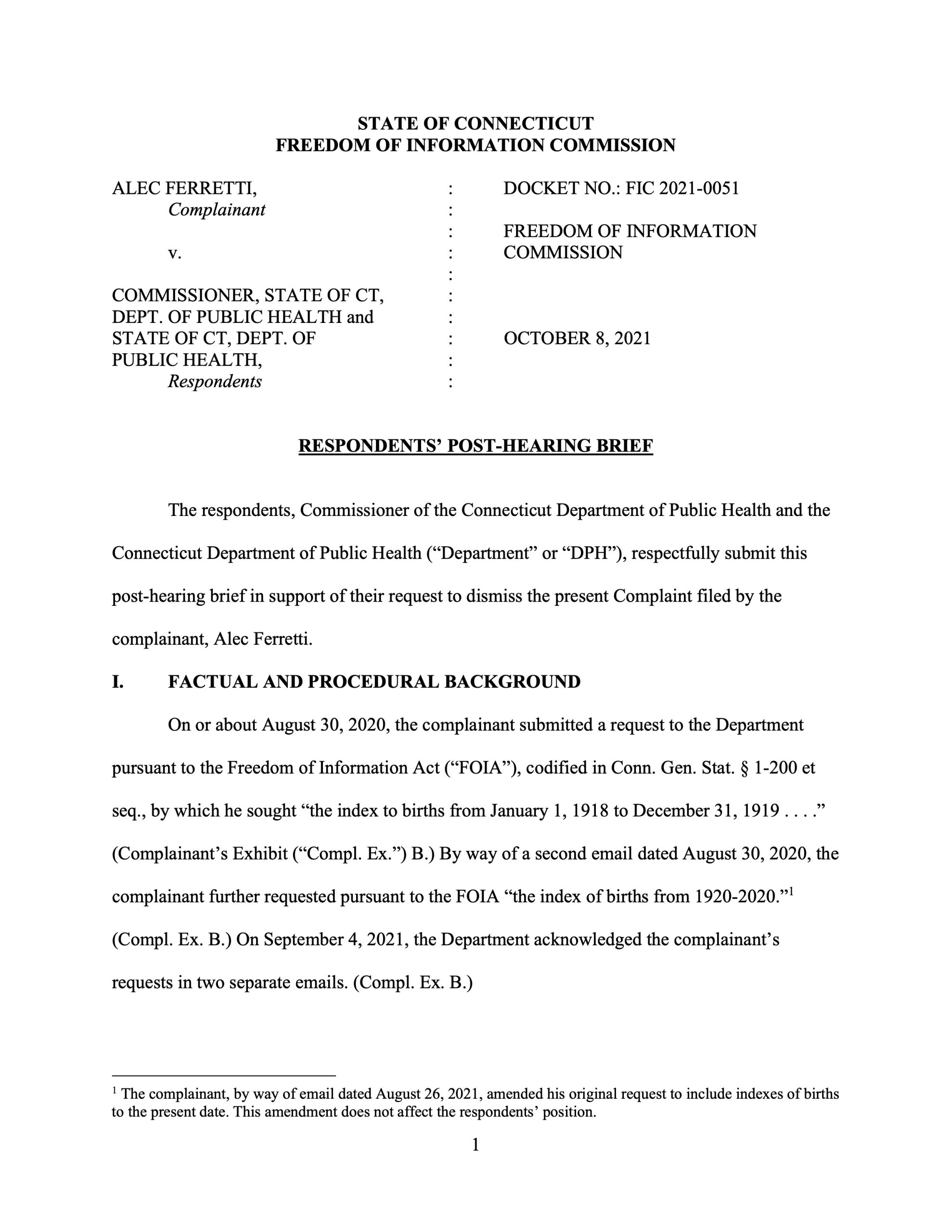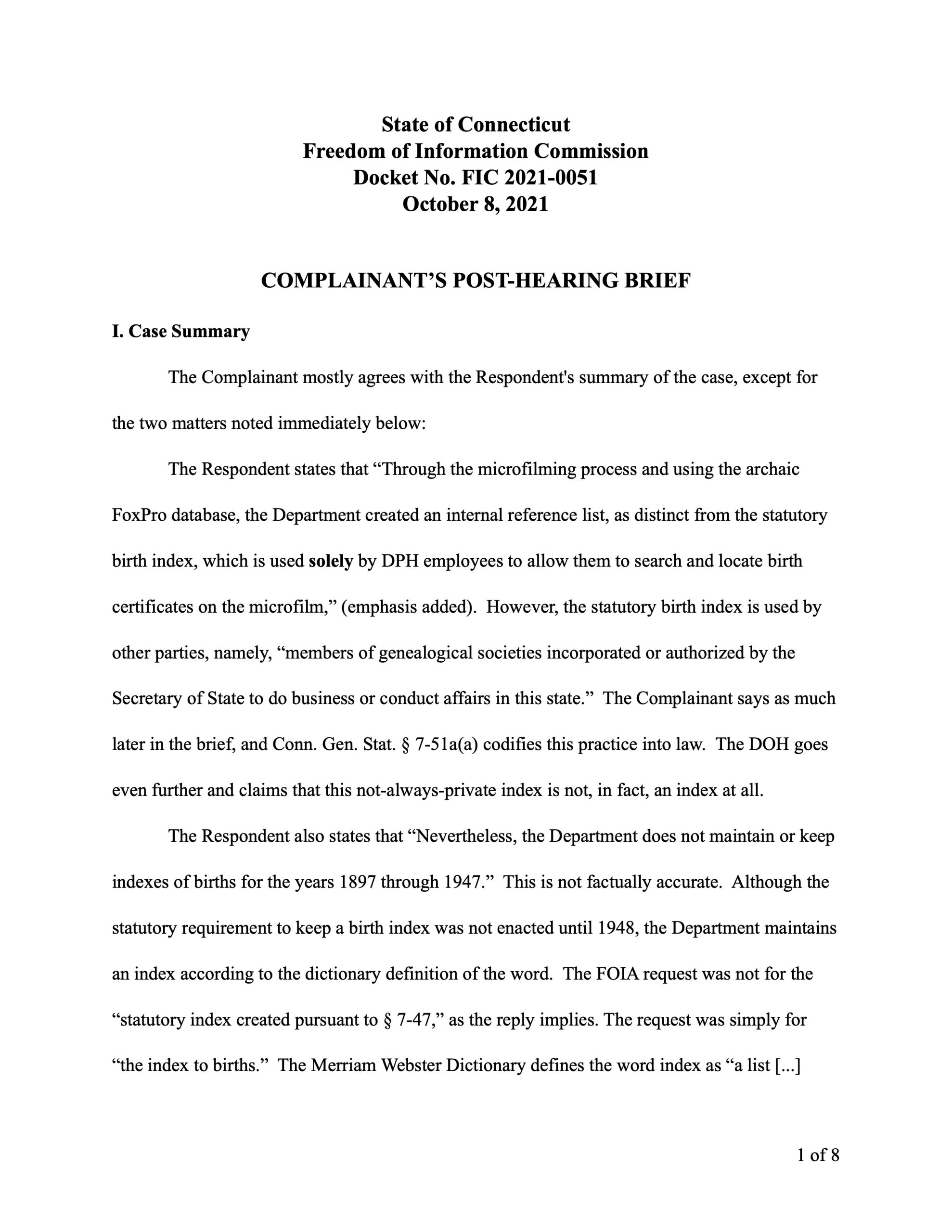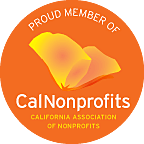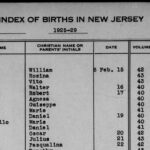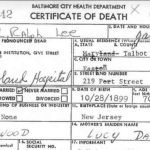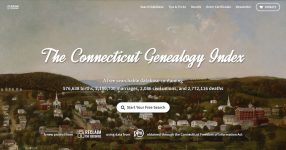 The Connecticut Genealogy Index is now online
The Connecticut Genealogy Index is now online
These 5.5 million records are now freely searchable at ConnecticutGenealogy.org.
The original data files are also freely downloadable and in the public domain, and are linked from that website, or directly from the Internet Archive: Connecticut Birth Index files · Connecticut Marriage Index files · Connecticut Civil Union Index files · Connecticut Death Index files
Hello again from Reclaim The Records! Today, we come to you with a long-awaited present: millions of new free genealogy records — or at least, new searchable and downloadable indices to those millions of records, and helpful instructions on how you can order the underlying certificates, even very recent ones. And of course, we also have yet another Kafkaesque story about why the world is still missing public access to even more years of this great data, and how we’re working to fix that.
Introducing ConnecticutGenealogy.org! It’s a FREE searchable database of 576,638 births, 2,180,700 marriages, 2,086 civil unions, and 2,772,116 deaths from the state of Connecticut, spanning three centuries. Some of this data had been online before, scattered across several other websites, but with fewer years, in non-downloadable and non-shareable formats, locked behind paywalls, and/or with tools that couldn’t handle searching the quirks and oddities in the data very well. Well, now it’s all in one place, and we think we’ve got better data and better tools, and we’re here to tell you all about it!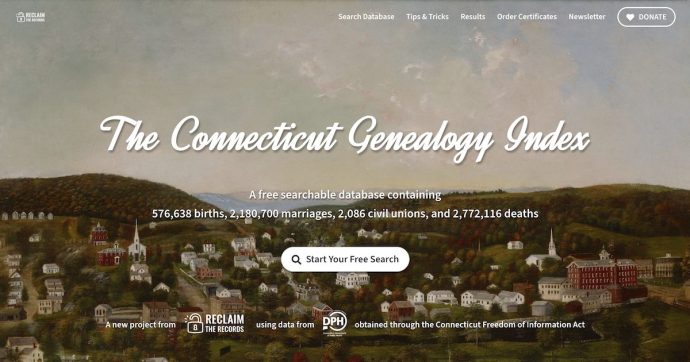
ConnecticutGenealogy.org includes the first-ever online publication of Connecticut birth index data from 1897-1917, and this new data is the only statewide index of Connecticut births that exists publicly online anywhere. (Yay!) We also acquired marriage and death index data from 1897 through 2017, while the next most complete online version of the index only had data through 2012. And our search engine is set up to better handle some of the weirdness in this data, such as the official records from 1969-1979 only having the first five letters of each person’s given name, and some of the pre-1925 data missing some names entirely. Our search engine also has all the fun bells and whistles like automatic nickname and partial name searches, wildcard searches, automatic typo or letter transposition searches, date range searches (even down to the exact day, not just the year), and so on.
And we even geo-coded all the data, and we also auto-supplemented all the data with county names.
That means you can use this new website to do much more complicated things with this data, like search for every person named Elizabeth and no last name provided, and in any type of Connecticut record dated between July 13, 1902 and February 8, 1903, and within 25 miles of the town of Hamden — and get back hundreds of results that might help you find her, even if she was listed in the record as Eliza, Lizzie, Bessie, or Elise. You can even make queries like “show me all births in Town X or County Y in early August 1908” without specifying any name data at all which is so important when it comes to finding that elusive relative’s record, especially because we’ve discovered that over 100,000 of these records (particularly ones from pre-1925) are missing a given name, a surname, or both, often due to the original handwritten records’ illegibility.
And we even added graphs and maps, which update along with the search results! Because those are fun! 💫
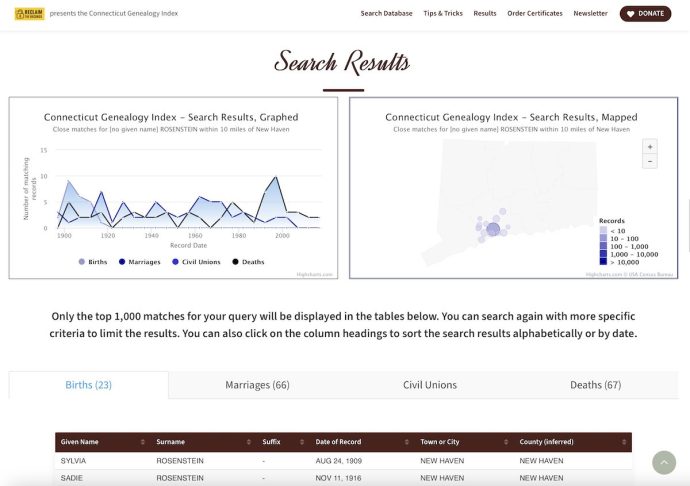
And we’re also publishing for the first time anywhere the Connecticut civil union database for 2005-2015. These unions were formally registered at the state level beginning in October 2005. Nearly all of these were automatically converted over to full state-recognized marriages in October 2010, then federally recognized in June 2015. Earlier records for domestic partnerships (which are legally distinct from civil unions, at least in Connecticut), were filed with some of the individual towns and cities in Connecticut dating back to circa 1993, or with religious institutions, but were not kept at the state level, and are not included in our database. Our huge thanks to genealogist and archivist Jeremy Berry-Cahn, who has been doing the first concerted project (that we know of) to catalog and acquire all domestic partnership and civil union genealogical datasets in the United States.
To obtain all this great data we (and Jeremy) submitted a few Connecticut state FOIA requests, made a few calls, and cut the state a few checks. The process for getting these indexes was almost entirely amicable, and did not require any litigation. However, we’ve also got a ridiculous situation dragging on in the state, to try to get more years of birth index data. More on that in a sec…
I found a name! But how do I get a copy of the actual certificate?
Well, the website gives more complete instructions, but let’s review them here briefly. To order a certified copy of a vital record, you can write to the state, meaning the Connecticut Department of Public Health, which has statewide records going back to 1896. But for shorter processing times, it is preferable to order directly from the town in which the event occurred. So if you know an event happened in Town X, you should probably try getting the record from the clerk of Town X, rather than asking the state and waiting a while.
Connecticut marriages and deaths are open records and may be obtained by anyone, while births and their associated indexes are currently closed for 100 years. There is no provision to request an uncertified copy of a vital record, but there is a very simple and very awesome workaround to get more recent birth records.
Ready? Okay. Any person who holds a membership in a genealogy society authorized to do business in Connecticut may present a card to a local or state clerk to obtain birth records within the closure period. See a list of those state-recognized societies, fourteen of them at the moment. So when making a request to a clerk, you should include a photocopy of your identification and your Connecticut genealogy society membership card with your mailed request.
Once more, with feeling: anyone can get any Connecticut marriage or death record, and if you belong to a recognized Connecticut genealogy society, and you have your physical membership card handy, you can get a copy of any Connecticut birth record, and you don’t have to wait a hundred years. (Gosh, if only more states were this amenable and sane about public records access…)
But now we come to the Kafkaesque nightmare, because of course
Acquiring all this index data from the state was relatively straightforward until we came to the question of getting more birth index data. We are currently battling with the state of Connecticut over this issue, although we are technically not in the court system…at least, not yet. And this ongoing fight has been the primary reason we did not announce this data earlier, as we had been hoping (and are still hoping!) to get a complete birth index to the present day. After all, if any Connecticut genealogy society member can get any actual Connecticut birth certificate from any year, then why can’t we get a basic birth index dataset from any year? What’s wrong with seeing just a list of names from 1940 or 1980 or 2010, if the full underlying records are essentially open?
Well. In August 2020, we made a Connecticut state FOIA request for the remaining unreleased birth index from the state, everything from January 1, 1918 to the present. As time has marched on, five and a half more years of these older records have since passed beyond the purported one hundred year restriction, so at the very least those 1918-1923 years of birth index data ought to be available to the public, nevermind the other 100+ years of more recent birth data.
Citing delays from covid, the Connecticut Department of Public Health (DPH) did not respond to our FOIA request until February 2021, at which point multiple follow-ups had already been made. And when they finally responded, the news was not good. They told us that index to births from less than 100 years ago could not be released, as they claim that there is a legal question about whether the provision restricting access to certified birth certificates, Conn. Gen. Stat. §7-51, extends to the basic name indexes as well. We think they’re wrong, but this is not an uncommon stance for a state to take when we fight with them, trying to apply legal restrictions that were only meant for actual record copies to the underlying basic finding aid or index.
But Connecticut’s response was worse than that. They also said that even the much older years of the state birth index, the ones from more than 100 years ago, could no longer be released to FOIA requestors, even though we already had the 1897-1917 section in hand (and now online) from a previous request. And the reason they gave was that all this state data is stored in a very very very old and rickety FoxPro database, and the one and only state staffer who was familiar with such an outdated data program had recently passed away. And she was the one who had previously helped give us the export of the 1897-1917 segment of the data.
In other words, Connecticut doesn’t want to give us, or anyone else, any recent birth index data, for reasons we think are both silly and incorrect, and they don’t even want to give us the indisputably very old birth index data because the state of Connecticut no longer has the technological knowledge to export parts of their own database, because their vital records database software is between 29 and 32 years old and their only employee who knew how to use it died. This is…not great. Not great for us as researchers, and frankly not great for the state itself, to potentially lose their own data to lock-in and obsolescence.
Naturally, we appealed this denial to the Connecticut Freedom of Information Commission (FOIC), whose purpose “is to administer and enforce the provisions of the Connecticut Freedom of Information Act, and to thereby ensure citizen access to the records and meetings of public agencies in the State of Connecticut.” They issue binding determinations in cases when members of the public believe they were wrongly denied public records. Similar quasi-judicial agencies exist in other states, such as Pennsylvania and New Jersey.
Again, citing covid, the FOIC was a bit slow to respond, but a hearing was set up for the fall of 2021, in which RTR and the DPH had to submit two rounds of briefs arguing their positions. We argued the two points that had been brought up in the initial denial: that the basic indexes were not restricted for 100 years, and that there was no real technological impediment to the DPH exporting the older records. Surely they could hire an outside consultant to help them convert, export, or otherwise re-engineer such an immensely important collection of state data? Worst case scenario, could they maybe, like, print it out?
Meanwhile, the DPH made a few brand new claims to the FOIC as well, such as a purported lack of any state birth indexes at all for some of the years. (We’re kind of not sure whether it would be better if they were telling the truth about this data hole or not.)
A lot of these disagreements about the meaning and intention of the law stem from very specific words and phrases that appear in the statute, sometimes as specific as the placement of modifiers. You may read all of the paperwork if you would like to understand the full case, as the issues we argue are complex, but we have summarized our main points below, excerpted directly from the filings:
“The Respondent [Connecticut Department of Public Health] claims that birth indexes created less than 100 years ago are unambiguously exempt from FOIA by selectively quoting § 7-51, leaving out the fact that this provision only applies to certified copies of birth records. § 7-51’s initial text is that “The department and registrars of vital statistics shall restrict access to and issuance of a certified copy of birth and fetal death records and certificates less than one hundred years old, to the following eligible parties…,” (emphasis added). Although they claim this unambiguously includes an uncertified birth index, instead this unambiguously precludes the birth index, as it need not be certified. This statute does not govern the release of uncertified indexes. […] The Respondent continues to discuss the legislative history of these provisions, stating that if the Legislature wanted to explicitly make birth indexes a public record, they could have. This is true, but also irrelevant. The purpose of FOIA is to make all records public by default.
The Respondent is relying on a definition of an index that does not match that which is in the dictionary. They claim that their database of who was born before 1948 is not an index, while that is the very definition of an index – it is a finding aid to an otherwise hard-to-navigate subject matter (in this case, sequentially-filed birth certificates). Although the law did not require them to keep an index until 1948, all records held by an agency are subject to FOIA, including those which are not required to be maintained by statute. […] There is no semantic difference between an internal reference list and an index. They could call it a turducken, but it’s still an index.
The Respondent provides another reason why they will not export data from 1917-1947. The reference list is contained on an archaic FoxPro database, and they claim that they are unable to manipulate the database because the staffer who was familiar with it recently passed away. Registrar Frugale testified that she was afraid that attempting to export the database could lead to the file being corrupted, but admitted this was not based upon any advice from any IT professionals. […] If there exist any copies of the Foxpro file anywhere, then there is no risk from manipulating the database, as any copy could be exported, with backups extant in case of issue. If the state does not currently have someone available on staff who is knowledgeable enough to work with FoxPro, then they can certainly hire a vendor to handle these tasks, just as their now-deceased staffer did in the recent past. […] While it is the preference of the Complainant to receive the file in a modern format such as a csv, to the extent that is impossible for the Respondent to do that, it would be acceptable to simply provide an exact copy of the database file, in the native Foxpro format, leaving the migration work to Complainant. […] In short, the Respondent’s technological incompetence is not a valid reason for them to withhold nonexempt records, especially when nearly identical records have in fact been provided to the same Complainant in the very recent past.
We filed the last brief in October 2021, and so our case has lingered before the FOIC for almost two years now, and we’re still waiting. When we inquired as to why there was such a long wait from a regulatory body, we had some more Kafkaesque fun: we learned that our FOIA case fell into a covid-related gravity well.
During the pandemic, the governor of Connecticut had apparently tolled the statutory deadlines by which the Commission had to adjudicate state FOIA requests. But when the deadlines resumed, the older requests made during that pandemic time period fell into a limbo, where the Commission had no legal obligation to respond by a certain time. The legal deadline applied only to all new and future complaints. Thus, the FOIC have responded to the complaints from 2022, but are basically ignoring the older ones, including ours from 2021. This is obviously not ideal, and we are now stuck twiddling our thumbs waiting for them to issue a decision. And so here we are launching this ConnecticutGenealogy.org website today with a birth index for 1897-1917 and no way to know if anyone will ever have access to any of the other years of the birth index ever again, nor any agreement about whether the state will ever bother to update or export their senescent FoxPro database that indexes state births, which they now also claim in their filings isn’t even an index at all.
On top of that, we have been fighting this case pro se, without lawyers. One of our intrepid directors, genealogy badass Alec Ferretti, has been handling all of the filings himself, going head-to-head with the State Registrar and the Attorney General’s Office, and we think, holding his own! We did not retain counsel for this project because, well, lawyers are expensive. But taking on these agencies without legal representation is never ideal, and if we ever want the state’s precious data to be online, or anywhere other than a very old and decrepit FoxPro database that not a single person on their own staff can use, then this is probably what we’re going to have to do.
And we can only do that with your help. If you like seeing records like these great Connecticut vital indexes go online for free, for everyone, forever, and you want to see us keep doing this kind of thing, and in more states nationwide, please consider making a donation to help fund our work. We really appreciate your support! You can donate on our website.
Thanks, and we hope you enjoy the new database! Happy searching!
State or Vital Records Jurisdiction: Connecticut
Government Agency: Connecticut Department of Public Health
Law: Connecticut Freedom of Information Act (CT FOIA)
Record Type: Birth Records · Civil Union Records · Death Records · Marriage Records
Record Years: 1897-2017, with some gaps depending on record type
Record Format: Index
Record Physical Format: Data files
Number of Records (Estimated): About 5.5 million

